Public Notice - 3913 Hillsdale Street
View the proposed development happening at 3913 Hillsdale Street
Public Notice - 1705 Neville Drive
View the proposed development happening at 1705 Neville Drive
Public Notice - 2100 Garry Street
View the proposed development happening at 2100 Garry Street
Regina Construction Season Passes Halfway Mark
very effort to minimize impacts on residents through extensive planning and coordination. Residents
are encouraged to plan ahead by visiting the Road Report at
Regina.ca/roads and allow extra travel time, particularly as the school year begins. These road
closures and restrictions will integrate directly into Waze, which populates closures onto Google
Maps. Residents can visit Regina.ca/construction and our social media channels for the latest
project updates. - 30 - Media contact: mediarelations@regina.ca 306-777-7486
PL202400083 - 1602 & 1650 Winnipeg Street
Public Notice - 1602 & 1650 Winnipeg Street
Infrastructure Development
and site conforms to all bylaws. The process also requires notification to property owners in the
vicinity, so any comments will be summarized in the report. Heritage
designation and heritage alteration of the building will be managed through separate processes.
Architectural detail is outside of the scope of a discretionary use application. Is the MJB a
designated heritage building? The original 1930 MJB is currently on the Heritage Inventory list.
The later additions to the MJB are not part of this inventory nor part of the heritage significant
characters of the building. The City will be putting forward a recommendation to Council that the
original 1930 building be officially designated as a municipal heritage building as part of the
process of proceeding with redevelopment. The additions to the original building will be demolished
to allow for the development of new spaces such as the multi-purpose room/gymnasium. What are the
requirements that must be incorporated into the concept design related to heritage? Any proposed
design must demonstrate alignment with the standards and guidelines for the conservation of
historic places in Canada
Municipal Justice Building
In 2016, the Transit Fleet Maintenance Facility project was approved for a New Building Canada
Fund, resulting in an approximately one-third funding split between federal, provincial and
municipal governments. The City is excited to partner with the federal and provincial governments
and share the cost of building a new Transit Fleet Maintenance Facility. The estimated cost of the
project is about $31 million. Sod-turning of the new facility took place on August 14, 2018 with
Mayor Michael Fougere, federal minister Ralph Goodale and provincial minister Warren Kaeding. The
current Transit Fleet Maintenance Facility is nearly 70 years old, was originally built to repair
street cars and not all types and lengths of City’s buses can be repaired inside the facility. It
will be repurposed for Roadways vehicle and equipment storage. The project involves constructing a
new facility that will be attached to the existing Transit Operations Centre at 333 Winnipeg
Street. The facility will include both 40 foot and 60 foot full-service and repair bays complete
with hoists for the maintenance of the City’s bus fleet. This repair shop will meet the growing
needs of public transit and Regina residents. The new facility will enable the City to meet the
service level needs of the community into the future and support the development of complete
communities through the delivery of transit to existing and new neighbourhoods. The new facility
will improve operational efficiencies, safety for employees who maintain the bus fleet and the City’�
s ability to maintain a safe fleet for use year-round. Project Funding 2016 $5.3 million 2018 $12.4
million 2019 $12.3 million 2020 $1.9 million The estimated cost of the project is about $31 million
and is roughly split three ways between the City of Regina, Province of Saskatchewan and Government
of Canada. Timeline Award construction tender – July 2018 Construction begins – August 2018
Facility occupancy – early 2020 Timing may change due to weather and other unforeseen
circumstances. Frequently Asked Questions What’s wrong with the current facility? The existing
facility is nearly 70 years old and is no longer able to support the functional requirements needed
to provide an appropriate level of service to the transit fleet, both in terms of number of buses
and types of bus fleet that can be housed and repaired. Where will the new facility be located? The
new facility will be attached to the existing Transit Operations Centre at 333 Winnipeg Street.
What will happen to the current facility? The existing Transit Maintenance Facility will be
repurposed for Roadways vehicle and equipment storage. How much does the facility cost and where
did the money come from? The total cost of the Transit Fleet Maintenance Facility project is about
$31 million with each level of government paying roughly one-third. What are the benefits of
getting a new facility? This new facility will enable the City to deliver expanded transit services
to existing and new neighbourhoods. The new facility will be designed and constructed to
contemporary energy, environmental and sustainability standards to improve the working environment
and reduce greenhouse gas emissions.
Transit Fleet Maintenance Facility
The Waste Management Centre will be a new office and shop facility located next to the Fleet Street
Landfill, consolidating the City’s Solid Waste Department and services at one location. This new
facility will be able to expand so waste management services can continue to meet the needs of
Regina’s growing population. The estimated cost of the project is about $35 million and is funded
from the Solid Waste Reserve. Much progress has been made since the initiation of this multi-year
project in 2016. Site servicing began in September 2018 and is now complete. Facility construction
expected to begin March 2019. Existing facilities that currently hold the Solid Waste department
equipment and staff are inadequate. The department is decentralized, working from multiple
facilities in the Public Works Yard, at the Landfill and at 500 Arcola Street. As the city
continues to grow, the number of Solid Waste collection vehicles and staff has grown and is
expected to continue to grow. The new facility will centralize Solid Waste’s operations and
associated programs at the Landfill in a facility that will meet current and future program needs.
The facility will provide a model of efficiency between the Solid Waste branches by sharing crew
spaces, office support areas and vehicle and equipment storage. Corporate Fleet Training space
needs will be accommodated in the facility as well as accommodating fleet maintenance for the waste
equipment on site. The new facility will be designed and constructed to accommodate between 10 and
25 years of growth. This will allow for other Transportation & Utilities Division functions to
potentially be located on this site in the future. The completion of this project will provide much
needed flexibility within the Public Works Yard. The freed up space there will allow the
Transportation & Utilities Division to consolidate vehicle and equipment storage on one site,
increasing operational efficiencies. Project Funding Previous Years $1.71 million 2017 $2.9 million
2018 $11.9 million 2019 $11.6 million 2020 $7.8 million The estimated cost of the project is about
$35 million and is funded from the Solid Waste Reserve. Timeline Award Site Development Contract –
August 2018 Issue Request for Pre-Qualification for Facility Construction – July 2018 Site
development began – September 2018 Award Facility Construction – January 2019 Facility construction
begins – March 2019 Facility occupancy – Fall 2020 Timing may change due to weather and other
unforeseen circumstances. Frequently Asked Questions Why is this centre being built? There are many
reasons. Existing facilities that currently hold the solid waste equipment and staff are
inadequate. As the City continues to grow, the number of Solid Waste collection vehicles has grown
and is expected to continue to grow. This will continue to place increased pressure on the existing
facilities, already at or beyond capacity. Solid Waste Department staff are currently located in
four separate facilities causing inefficiencies and limiting the potential for improved teamwork.
How much does the facility cost and where did the money come from? This planned infrastructure
project is 100 per cent funded from the Solid Waste Reserve. We have budgeted $11.6 million in
2019. The total estimated cost of this project is $35 million and will be completed late 2020. Is
the City taking on new debt to fund this project? No, this planned project is 100 per cent funded
from the Solid Waste Reserve. Where will this centre be located and why? It will be located
directly adjacent and to the east of the Fleet Street Landfill. This land is situated ideally to
satisfy the needs of the landfill, the new Waste Management Centre, as well as provide future
operational opportunities for other services. What is going to be in the Centre? The new Waste
Management Centre will include office, shop, lab space and storage for the following programs and
services: Solid Waste Department Waste Diversion Landfill Operations Solid Waste Collection
Environmental Services Business Support Fleet Services Department Fleet Maintenance Fleet
Operations (Fleet Training) Supply Services (Parts and Fuel) The Waste Management Centre will also
have an education space to provide residents with opportunities to learn about waste diversion in
order to extend the life of the Landfill. ...
Lead Service Connections
ry directly to the individual homeowner. We also receive the results along with the invoice. The
results are not be posted or shared and will only be reported in an
aggregated manner that prevents the individual properties that participated from being identified.
To receive testing forms and bottles, first contact us to determine if you are eligible and provide
the appropriate documents. Eligible participants will receive a laboratory requisition form by
mail. Complete the form and take the form to the Roy Romanow Provincial Laboratory (RRPL) to obtain
a sample kit. Use the kit to conduct the sampling procedures and complete the sampling form. Return
water sample, sample form and laboratory requisition to the SDCL. In-Home Point of Use Testing Lead
Removal Water Filter Program If our records indicate your building is served by a known lead
service connection, water testing has been done through a Lead Testing Program and indicated levels
above current Health Canada Guidelines, or the City has confirmed your building has a private lead
service line, you are eligible to receive a free water filter annually through our Lead Removal Filter Program. There are three options
available to eligible residents - a free filtered water pitcher, a water filter rebate, or a rebate
for purchasing bulk water. Request a filtered water pitcher and a one-year supply of filters from
the City and have them delivered right to your door. Water Filter Request Application The City is
not responsible for the installation and maintenance of the unit or the installation of replacement
filters. Free Filtered Water Pitcher Purchase your own tap-mounted unit, under-the-counter unit,
fridge water-dispenser unit, filtered water pitcher, or purchase bulk water and receive a rebate of
up to $100 on your utility bill. Water Filter Rebate Application The filter must be certified to
National Sanitation Foundation’s Standard 53 (58 for reverse osmosis systems) for lead removal to
qualify. There are several kinds of filters available to purchase including: pitcher style
pour-through container left in the fridge attachment that is screwed on to the tap on-counter unit
that typically is plumbed to the tap below counter system that usually requires the installation of
a separate drinking water tap Most home stores and super centres have some type of filter system
available that conforms to the standard for lead reduction. The price of filters vary based on type
and features. The simplest and smallest pitcher-type system may cost anywhere from $20 to $100,
while a complicated and extensive below counter system may cost in the range of $1,000. You can
apply for the filter rebate, which is applied as a credit to your utility bill, by filling out and
supplying the application form. Water Filter Rebate The City is working to remove all lead service
connections by 2036 to eliminate one key source of lead in drinking water. Replacements will be
coordinated with corporate construction projects. Replacing only the City-owned portion does not
solve drinking water concerns if lead plumbing materials also exist on the private side. Starting
in 2022, privately-owned lead service connections will be replaced when the adjoining City-owned
connection is replaced. Residents will be notified of replacement details before any construction
work begins and be provided with interest-free payment options for replacement. Replacing the
entire lead service connection will remove one key source of lead in your drinking water. Residents
who have had the private side of their service connection replaced are eligible for free City side
replacement. Property owners may request we replace the City-owned lead service connection, but the
private side must be changed first. Locations where the private side is not lead will be
prioritized for completion to remove the service connection source of lead and effectively reduce
lead in the tap water. City-Owned Lead Connection Replacement Application Privately-Owned Lead
Service Connection Replacement Financial Payment Options The City is offering property owners
deferred payment options, recognizing that residents may not have planned for the cost of replacing
the private side of a lead service connection. The following payment options are available to
property owners: Direct payment to the contractor at the time of replacement. Five-year equalized
payment plan, plus an up-front administration fee. 10-year equalized payment plan, available only
to property owners who meet the City’s Affordable Access Program criteria. Five-year Equalized
Payment Plan (Interest Free) You will pay a one-time $240 administration fee and the City will pay
the contractor and attach the cost for the private side replacement to your property taxes. One
fifth of the total amount is then due and payable when your taxes are due. In each year thereafter,
one fifth of the amount is due and payable until the amount is paid in full. If property owners are
on the Tax Installment Payment Plan Service (TIPPS), you would make 60 equal payments after the
replacement has been completed. An agreement between the City, the property owner, and the
contractor is required as well as a financing agreement. Ten-year Equalized Payment Plan (Interest
Free) If eligible, there is no up-front administration fee. In this case, the City pays the
contractor and attaches the cost for the private side replacement to the property owners’ taxes.
One tenth of the total amount is then due and payable when your taxes are due. In each year
thereafter, one tenth of the amount is due and payable until the amount is paid in full. If you are
on the TIPPS program, you would make 120 equal payments after the replacement has been completed.
An agreement between the City, the property owner, and the contractor is required as well as a
financing agreement. The ten-year equalized payment plan option is only available to property
owners who meet the City’s Affordable Access Program criteria. If you are unable to replace the
lead water service connection at this time, you may wish to purchase a filter certified to
NSF/ANSI-53 (NSF/ANI 58 for reverse osmosis systems) for lead removal. Even after both sides of the
lead service connection have been replaced, small particles of lead can remain in your home’s
internal plumbing. Frequent flushing of your home’s internal plumbing can speed up the removal of
these particles. This flushing process includes: Installing a NSF-53 (58 for reverse osmosis
systems) filter. Running cold water taps before you consume water - remember to only use cold tap
water for drinking or cooking, since hot water increases the leaching of lead and other metals from
your plumbing. Remove and clean tap screens - after lead water service connection replacements it
is recommended this be done more frequently as more lead particles may have broken free during
replacement work. Drain your hot water heater to remove accumulated sediment.
Replacing Lead Service Connections
View the Lead Service Connection Management Program's Qualified Vendor Roster and contact
information. ...
PL202300178_Pln_20240315_4
Public Notice - Design Package 4 (March 21)




